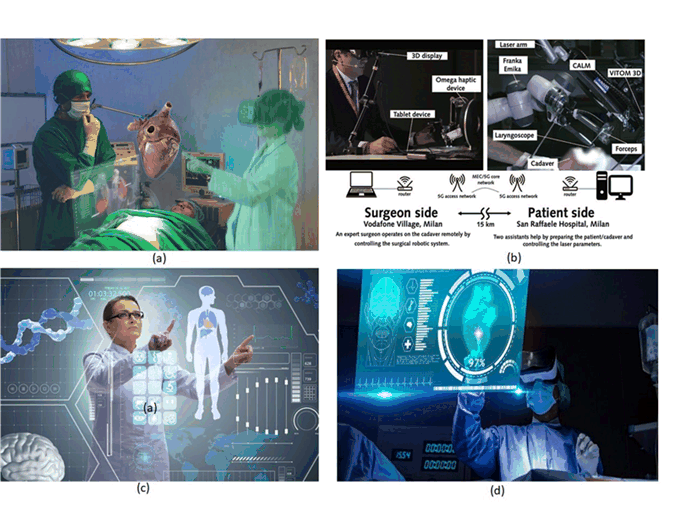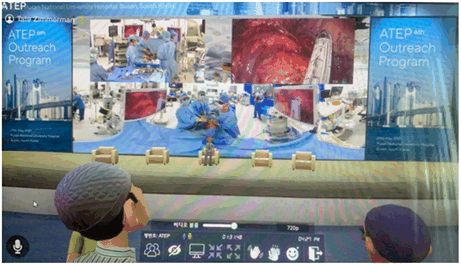Content for TR 22.856 Word version: 19.2.0
1…
5…
5.2…
5.3…
5.4…
5.5…
5.6…
5.7…
5.8…
5.9…
5.10…
5.11…
5.12…
5.13…
5.14…
5.15…
5.16…
5.17…
5.18…
5.19…
5.20…
5.21…
5.22…
5.23…
5.24…
5.25…
5.26…
5.27…
5.28…
6
7…
7.2
8
A
B
C…
5.10 Use Case on mobile metaverse for Critical HealthCare Services
5.10.1 Description
5.10.2 Pre-conditions
5.10.3 Service Flows
5.10.4 Post-conditions
5.10.5 Existing feature partly or fully covering use case functionality
5.10.6 Potential New Requirements needed to support the use case
...
...
5.10 Use Case on mobile metaverse for Critical HealthCare Services p. 43
5.10.1 Description p. 43
Mobile metaverse for Critical HealthCare Services. Immersive interactive mo]]bile ]services encompass multiple services such as gaming, education, healthcare, shopping, recreation etc. Healthcare is a lifesaving critical service, which will benefit the most from mobile metaverse services. Remote surgery and surgeon training are already emerging examples, for geographically spread specialized surgeons, students and patients. Healthcare making use of mobile metaverse services can save lives by providing healthcare services at the earliest, train students better and free surgeons/doctors from being physically present at patient's location. This area will encompass services such as surgery, medical student training, surgeon training. It will enable remote physician and patient examination. Mobile metaverse services can be characterized as a typical class of application that involves a server and a client device. This class of application will typically exchange haptic signals (forces, torques, position, velocity, vibration etc.), video and audio signals. Mobile metaverse services largely depend on low latency, highly reliable, secure wireless communication networks. [14], [32], [33], [36], [37]
Mobile metaverse-Surgeries. Normally, surgeons have to be physically present at hospital to perform their surgeries. Surgeons and patients may have to travel a great distance for surgeries, which is resource intensive and burdensome. The outbreak of coronavirus has further proves the case for remote surgeries. At present, there are increasingly more surgical rooms adapted with advanced surgical robots and doctors can remotely operate on the patients by controlling these surgical robots as shown in Figure-5.10.1-1b [35]. Mobile metaverse services can bring doctors and patients closer virtually, which further improves the accuracy and surgery flexibility. It can also facilitate consultation to provide suggestions and domain knowledge to reduce risks in actual operation. Recently, a real time remote breast cancer surgery was performed using private 5G network and head mounted display. Dr. G, physically present in the operating room, wore a head mounted display and could see the crucial information displayed by the goggles and performed breast cancer surgery remotely. Dr. G received constant advice from Dr. A, who was seated on the stage at the congress of Spanish association of Breast Surgeons, 900 km away from the surgery room [34], [35].
Mobile metaverse Physician Consultation. With the outbreak of COVID, virtual consultation through audio and video conference calls has gained considerable momentum. Mobile metaverse services enabled by tactile sensors along with video and audio media can provide a rich and successful experience to both physician and patient. The ability to perform mobile metaverse service consultation without the need for the doctors and patient to be physically co-located is an extremely efficient prospect. Doctors can potentially use mobile metaverse services to examine and interact with representations of aspects and views of the patient, and benefit from a plethora of medical advice database as shown in Figure-5.10.1-1.c. 5G communication is one the key factors to enable mobile metaverse service based physician consolation. Doctors and patients both need high throughput, ultra-reliable and low latency 5G communication for these services to succeed. [30], [32].
Mobile metaverse Body scan and vitals. Mobile metaverse services can significantly improve and change the way current body scan diagnostics and vital statistics are gathered. Mobile metaverse services can be utilized to see the real-time diagnostic data of the patient such as body temperature, heart rate, blood pressure, breathing rate along with MRI, CT and 3D scans as show in Figure-5.10.1-1.d. Medical challenges such as vein detection for IV, shots etc., can easily be resolved using mobile metaverse services. These will help medical professionals to detect, diagnose and treat a patient [30], [32].

The examples in Figure 5.10.1-1 feature the use of mobile metaverse services for a) Training Surgeons, b) remote surgery, c) physician consultation d) remote medical diagnostics. (Image source: healthcareoutlook.net, courthousenews.com, gmw3.com, ourplnt.com)
Mobile metaverse Training Medical Students. Surgeries performed by surgeons all over the world can be used to train students using mobile metaverse services. Students can observe a live surgery with almost all the important vital and view on display, as they would be displayed to a surgeon. Further, the students can view the live surgery from different viewing perspectives, hear surgeon's instruction, display of suggestions and domain knowledge as show in Figure 5.10.1-1.a. In May 2021, a live lung surgery was performed using an extended reality (XR) technology platform. More than 200 thoracic surgeons from Asian countries attended the outreach program and received training. The participants wore a head-mounted display (HMD) at their respective locations and participated in the program virtually represented by a digital representation (e.g. an avatar). They participants viewed the live lung surgery with lecture and 360deg high resolution surgical scenes as show in Figure 5.10.1-2 [31].

The source of Figure 5.10.1-2 is [31] (Image source: Journal of Educational Evaluation for Health Professions (Jeehp)).
5.10.2 Pre-conditions p. 45
Hospital Y has an enterprise subscription with MNO X, with which MNO provides the hospital and its staff with fault-tolerant and ultra-high reliable 5G communication as well as mobile metaverse services. Dr. Alex and Dr. Bob are renowned surgeons of Hospital Y, who are also trained to perform surgeries using immersive interactive mobile healthcare services.
Dr. Alex and Dr. Bob both have 5G based head mounted device (HMDs) and tactile gloves, which can communicate with those in the hospital surgery room virtually using digital representation of themselves (an avatar). The doctors are able to make remote use of actuators in operating room, though remote. The service requires extremely high reliability as a patient's life is at risk. 5G allocates sufficient communications resources, e.g. through the use of GBR QoS policy, to both the surgeons communications for the entire duration of the surgery.
5.10.3 Service Flows p. 45
- Dr. Alex and Dr, Bob are surgeons and senior surgeons of a renowned hospital. Dr. Alex is on a vacation with the family and Dr. Bob is attending a conference 300 miles away from Madrid, Spain.
- A patient, David, has had an accident and has been rushed to the emergency room of a local hospital. David has a bad head injury and needs an urgent brain surgery.
- The hospital requests that the surgeons Dr. Alex and Dr. Bob perform the surgery.
- Dr. Alex and Dr. Bob wear HMDs and tactile gloves and connect to the hospital surgery room virtually making use of the 5G system.
- David is in an operating room of the hospital equipped with advanced surgical robots and attended by the local doctors and nurse.
- The vital diagnostic information such as heart rate, BP reading, ECG etc., are virtually displayed to both the surgeons. The surgeons are able to view the surgery room and able to see each other using digital representations (e.g. avatars.)
- Dr. Alex and Dr. Bob perform the surgery remotely with the assistance of the robots and doctors and nurses at the hospital.
- The surgery successfully ends, after three hours of surgery and remote treatment without an interruption in the 5G connections.
- After the surgery, the patient is shifted from the surgery bed to an Intensive Care Unit (ICU) by the doctors and nurses in the hospital. Dr. Alex and Dr. Bob return to their vacation and conference respectively.
5.10.4 Post-conditions p. 46
After the surgery, the doctors and surgeons stay connected virtually to read the vitals of the patients. Once the patient's condition has stabilized, Dr. Alex and Dr. Bob disconnect their devices. The 5G system then releases dedicated communication resources (GBR QoS policy) from the devices used for surgery using 5GS.
5.10.5 Existing feature partly or fully covering use case functionality p. 46
- URLLC system design in clause 5.33 of TS 23.501 has proposed dual redundant system to achieve ultrahigh reliability. Though - in this system design- there are dual RAN connections, PDU session established, SMF and UPF but has a common DN and AMF nodes, which is a single point failure in the system architecture. URLLC system design is ultrareliable but not end to end ultra-reliable and fault tolerant. It also relies on the upper layer protocol such as IEEE 802.1 TSN (Time sensitive Network) FRER (Frame replication & elimination for reliability), to manage dual redundant systems such as replication and elimination of redundant packets or frames. A typical fault-tolerant system should not have single point of failures and manage system flow. Moreover, the use of FRER implies that the content is exchanged over both paths continuously, thus doubling the resources used over the radio.
- Redundant user plane paths based on multiple UEs per device has been proposed in Annex F of TS 23.501. In this system design, the device is expected to have two UE(s) and they independently connect to their RAN and have their own PDU sessions with a common DN. This system is not End-to-End fault tolerant since it has a common DN - a single point of failure- and requires dual UE(s) to achieve ultrahigh reliability. This architecture too assumes that some upper layer protocol (e.g. FRER) is used for replication and frame elimination, thus doubling the resources used over the radio.
- As per Multimedia Priority Service (MPS), mentioned in clause 5.16.5 of TS 23.501, allows service users priority access to the system resources under congestion, creating the ability to deliver or complete session of a high priority nature. Service users are priority users such as government officials, authorized users. Currently there are no requirements to identify mission critical users and its priorities such as emergency (under surgeries), surgeon training, scans and physician consultation.
- RRC controls the scheduling of user data in the uplink by associating each logical channel with a logical channel priority, a prioritised bit rate (PBR), and a buffer size duration (BSD), mentioned in clause 10.5 of TS 38.300. We can extend this to allocate logical channels for mission critical services such as metaverse for Critical-HealthCare services.
- The existing CMED in TR 22.826 specifies various possible healthcare support using ultra high-definition videos, tactile sensors and audio. Though this TR specifies the reliability of 99.999% but does not specify the fault tolerant end-to-end reliability, and also does not specify for metaverse, which is an interactive VR 360° streaming [41].
5.10.6 Potential New Requirements needed to support the use case p. 46
[PR 5.10.6-1]
The 5G system shall provide a means to synchronize multiple service data flows (e.g., heart rate, video, audio) of multiple UEs associated with Critical HealthCare services.